Best 14 AI Virtual Assistant Software in 2025

The digital revolution has changed the way we work, communicate and even carry out our day to day activities. Artificial intelligence has become the foundation of contemporary productivity solutions in this fast changing technical environment. By 2025, the rivalry with AI assistants will be intense, and the new features, cleverer algorithms, and unexpected novelties are launched. These smart digital assistants have changed to be more than just voice commands; they are now intelligent problem-solving companions that learn context, preferences and adapt to user needs.
The modern solutions of intelligent automation are the step of quantum leap in human-computer interaction providing an unprecedented level of personalization and efficiency. As a working executive, creative professional or even a lay user, who wants to streamline your workflow, these high-tech AI Virtual Assistant Softwares are redefining productivity and task management in the ever more interconnected world.
What is AI Virtual Assistant Software?
Artificial Intelligence (AI) virtual assistants are computer programs that utilize artificial intelligence. They also answer in human language in either written or recorded form. These advanced systems have the ability to interpret human speech patterns, due to natural language processing (NLP), which makes communication feel like a natural interaction. Such digital companions are not just command-and-response, and they also include machine learning algorithms that allow them to become better the more they are used.
Modern solutions incorporate modern cognitive computing features, thus they have the ability to process a complex request, analyze the data pattern and then respond in a contextually relevant manner. They are smart facilitators between people and online environments, and they can handle schedules, email, research, smart-home devices, and any number of other activities. These technologies have been developed over time to produce very strong applications that are capable of interpreting subtle conversations, recalling past interactions as well as predicting user needs by analyzing their behavioral patterns and preferences.
Brief Overview of How It Works
These smart systems are designed using sophisticated architecture which functions using a series of intertwined layers which are interrelated in a way which functions smoothly:
- Natural Language Processing (NLP): Sophisticated algorithms deconstruct the human speech or text input into meaningful elements and recognize intent, context and sentiment in the user request.
- Machine Learning Integration: Deep learning models capture user interactions, preferences and patterns and are continually improved through user interactions to become more accurate and personalized in their responses over time, producing a more personalized experience.
- Voice Recognition Technology: Advanced speech-to-text applications will interpret the audio signal to digital data, whereas text-to-speech programs produce voice responses that sound like human speech and follow similar patterns of conversation.
- Cloud-Based Processing: Complex queries are processed in real-time by powerful server infrastructure that accesses huge databases of information as well as utilizes distributed computing resources to achieve optimal processing.
- API Integrations: API integration allows easy connections to other applications, services, and third-party services so that these systems can carry out tasks across different software environments and obtain real-time data across different sources.
- Response Generation: Sophisticated algorithms generate proper responses, and perform the actions requested and give output to the users through many output channels such as voice, text and visual interface.
Key Features of AI Virtual Assistant Software
- Voice Recognition and Natural Language Understanding: Allows to communicate with ease using spoken words and conversation-based interfaces that can be used to interact with other humans in a similar fashion.
- Multi-Platform Integration: Create work across devices and applications and offer cross-platform experiences across smartphones, computers, and smart home devices
- Intelligent calendar planning and scheduling: Automate the booking of appointments, scheduling of meetings and monitoring of deadlines with intelligent conflict resolution
- Automation Tasks: Automate mundane tasks like processing of emails, data entry, generation of reports and workflow optimization
- Individualized Learning Algorithms: Adjust to the personal preference of users and they become more accurate and relevant with time by consistently studying their behavioral patterns
- Real-Time Information Retrieval: Offer real-time access to up to date information, weather, news and search results so that decisions can be made based on real time data.
Benefits of Using AI Virtual Assistant Software
- Increased productivity: Outsource non strategic functions to robots and spend more time on strategic planning and innovative work
- Cost Savings: Reduce the scope of adding human resources and still bring about effective services and operational efficiency
- Availability of 24/7: To provide a constant service delivery, the support and task execution should be done despite the time zones or business hours
- Better accuracy: Minimize human error in handling data and performing tasks, providing a higher quality and reliability of work in general
- Scalability: Be able to manage the growing workloads without correspondingly growing resources, which makes them suitable to growing businesses and expanding operations
- Improved User Experience: Develop user-specific interactions that respond to the interests and demands of individuals to create more interesting digital experiences
Top Use Cases of AI Virtual Assistants
Smart digital assistants have been used in various industries and personal situations, which proves their multifunctionality and usefulness. They are also good at scheduling meetings, working with emails, automation of customer service and data analysis in business context. Patients use them in healthcare organizations to make appointments, receive reminders of their medication and initial assessment of their symptoms. They are used by learning institutions in assisting students, delivery of course information and to automate administrative tasks.
These technologies are implemented on e-commerce websites to process customer inquiries, place orders and make product recommendations. The use of smart home applications allows controlling the operating devices by voice, monitoring the security systems, and optimizing the use of energy. These tools are used by content creators to aid their research, writing, and social media tasks and by financial services as aids in account inquiry, transaction processing, and fraud detection.
Best 14 AI Virtual Assistant Software in 2025
1. Amazon Alexa

The smart home market still remains under the control of Amazon intelligent assistant that has received new and improved conversational capabilities and an extended skill ecosystem. The 2025 version will have enhanced natural understanding of language, context retention and will be compatible with more than 100,000 smart home devices and services all over the world. Alexa is in the lead in automation through voice commands, shopping and entertainment.
Features:
- Smart home automation and management of devices via voice
- Large skilled library with more than 100,000 available skills by third parties
- Multi-room audio, intercom capability
- Ordering and purchasing support via the Amazon ecosystem
- Information delivery of weather, news, and real-time information Weather, news and real-time information delivery
Pricing:
- Alexa service: It comes free with Amazon Echo devices
- Echo devices: Echo devices: Starting at 49.99
- Amazon Prime connectivity: 139/ year
- Alexa for Business: Enterprise pricing: Custom
Pros:
- Wide smart home device compatibility
- Healthy third-party integration eco-system
- The ever-growing AI potentials
- High privacy options
Cons:
- Needs Amazon Echo device to be used fully
- Always-listening device privacy issues
- Poor conversational context memory
- Sometimes misconception of difficult questions
Website: http://amazon.com/alexa
2. Google Assistant

The most advanced AI Virtual Assistant Software, powered by Google, is doing well in search integration and contextual understanding capabilities since its launch in 2016. It provides better information retrieval and natural conversation understanding leveraging the enormous knowledge base and machine learning capabilities of Google. The 2025 release will be more multi-language friendly, have increased smart display compatibility, and integration with the Google Workspace services.
Features:
- High-level natural language processing and dialog management
- Google services(Gmail, Calendar, Maps) integration
- Real-time translation in multi-languages
- Smart display connection and images reactions
- Recommendations tailored to a user behavior
Pricing:
- Google Assistant: With Google account
- Google Nest devices: begin at $99.99
- Google Workspace: Built into plans
- Enterprise: Custom Pricing
Pros:
- Better search systems and retrieval of information
- Good background knowledge and talk flow
- Broad device support in Android ecosystem
- Good compatibility with Google services eco-system
Cons:
- Issues of privacy of data collection
- Restricted without Google account
- Irreproducibility between devices
- Most functions also require internet connection
Website: https://assistant.google.com/
3. Apple Siri

Over the course of 2025, Apple has made substantial improvements to its trademark intelligent assistant in the form of increased on-device processing, better voice recognition, and more iOS integration. As a leading AI Virtual Assistant Software, Siri is focused on user privacy by processing data locally and provides natural flow of conversation and a greater range of functionality throughout the entire Apple ecosystem. The most recent one involves enhanced Shortcuts automation, enhanced HomePod integration, and increased personal information management capabilities.
Features:
- Large-scale integration with iOS, macOS and Apple ecosystem
- Privacy and performance optimizations i.e. On-device processing On-device processing
- Automation of shortcuts to complex sequences of tasks
- Smart house control and homePod functionality
- iOS devices Personal information management
Pricing:
- Siri: Comes free with apple devices
- Apple equipment: Depends on line of product
- iCloud storage: Begins at 0.99/month
- Bundle: Apple One- beginning at $19.95/month
Pros:
- Superb privacy protection using on-device processing
- Cross-integration with Apple device ecosystem
- Natural language speech interaction and dialogue processing
- Good data security and encryption on a personal level
Cons:
- Only available to Apple ecosystem products
- A limited number of third-party integrations as compared to competitors
- Irregular handling of complex queries
- There are regional restrictions to certain features
Website: https://www.apple.com/siri/
4. Samsung Bixby
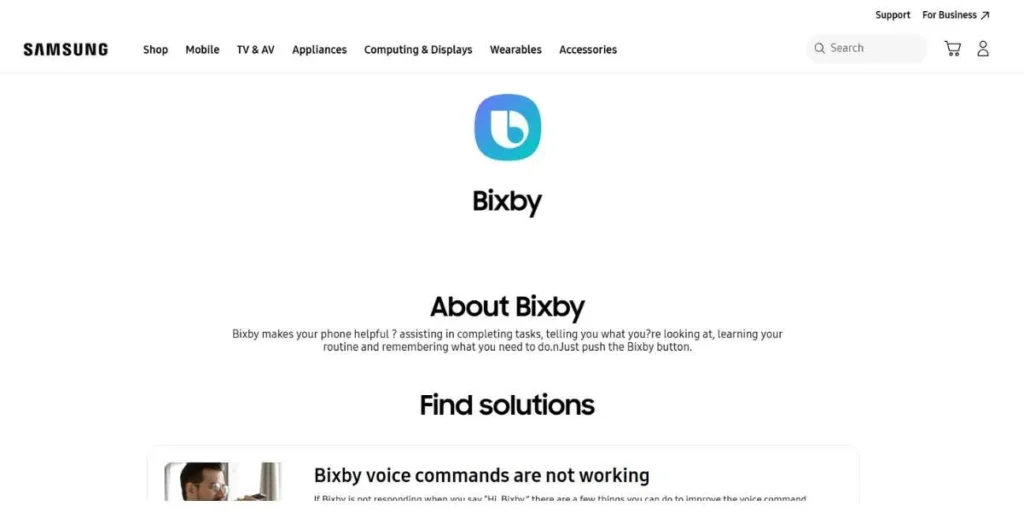
The intelligent assistant of Samsung is oriented to controlling all devices and integrating with the Samsung ecosystem, with notable enhancements by 2025. As part of Samsung’s AI Virtual Assistant Software offerings, Bixby has improved voice recognition, increased smart home capabilities with SmartThings, and is more capable in the broad Samsung product lineup that includes smartphones, TVs, and appliances. The app allows proprietary object recognition using vision, as well as customizable voice commands to provide custom user experiences.
Features:
- Flexible Samsung device control and automation
- Image recognition and retrieval using vision
- Samsung smart things integration (Smart home)
- Voice commend and rapid action customizable
- Voice, touch and vision multi-modal interaction.
Pricing:
- Bixby: Comes free with Samsung
- Samsung products: Depends on the type of product
- SmartThings Hub: begins at 69.99
- Premium features: This comes with the purchase of the device
Pros:
- Close knit with Samsung device ecosystem
- High levels of device control and automation
- Multiple forms of communication alternatives
- Unending feature upgrades and refinements
Cons:
- Confined to environment of Samsung devices
- Less third party integrations
- Variable recognition of voice accuracy
- Limitation of regional languages support
Website: https://www.samsung.com/us/support/owners/app/bixby
5. ChatGPT by OpenAI
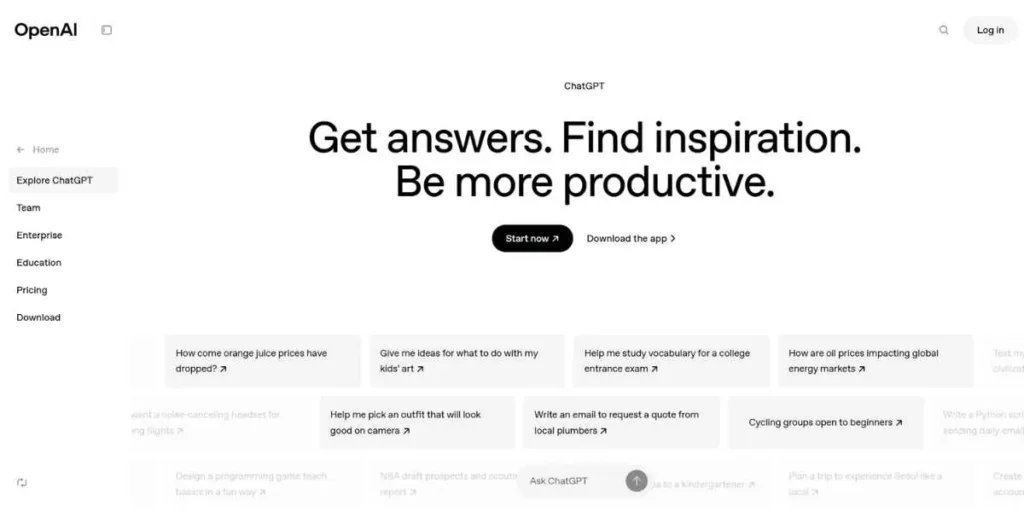
The revolutionary conversation AI of OpenAI has revolutionized human-computer interaction with its ability to use the natural language to a level never seen before and with its reasoning capabilities. The 2025 model is more accurate in facts, more creative in solving problems and more functional in analytical work in different fields. ChatGPT has outstanding generative capabilities, computer programming services, educational aid, and intricate query resolution at superb contextual retention.
Features:
- Context preserving conversational AI
- Ability to create content and writing skills
- Programming help and code generation
- Translations and multi-language support
- Connection to different apps and platforms
Pricing:
- ChatGPT Free: 0/ month with usage limits
- ChatGPT Plus: 20 dollars per month, priority access
- ChatGPT Team: 25 dollars per user fee on monthly basis
- ChatGPT Enterprise: Organizational pricing: custom
Pros:
- Great Communications skills & situational awareness
- Flexible use in various spheres
- Continuing knowledge and development opportunities
- Good creative and analytical problem-solving
Cons:
- It will need internet to be functional
- The inaccurate information generation potential is present.
- Restrictions in free tier
- Data processing privacy issues
Website: https://chatgpt.com/
6. Jasper AI

Jasper is a content creation and marketing automation tool that provides advanced writing support and brand voice optimization to business and content creators. The platform integrates artificial intelligence and marketing skills to create top-notch content in a wide range of formats that comprise blogs, advertisements, emails, and social media posts. The 2025 version of Jasper has an increased brand voice training, enhanced capabilities of SEO optimization, and better collaboration tools within content teams.
Features:
- Marketing materials generated by AI
- Training and consistency of brand voice
- Production of multi-formatted content (blogs, ads, emails)
- Keywords and optimization of SEO
- Content team collaboration tools
Pricing:
- Creator Plan: 39 dollars per month (per person)
- Teams Plan: small teams: 99/month
- Business Plan: The growing business $499/month
- Enterprise: Large organizations pricing
Pros:
- Niche attention to content marketing
- Brand voice tailoring and uniformity
- Good quality output and little editing is required
- Good template library and content formats
Cons:
- Greater cost than general AI assistants
- Poor out of content functionality
- Needs learning curve to make best use of it
- The only type of pricing model is subscription-based
Website: http://jasper.ai/
7. Notion AI
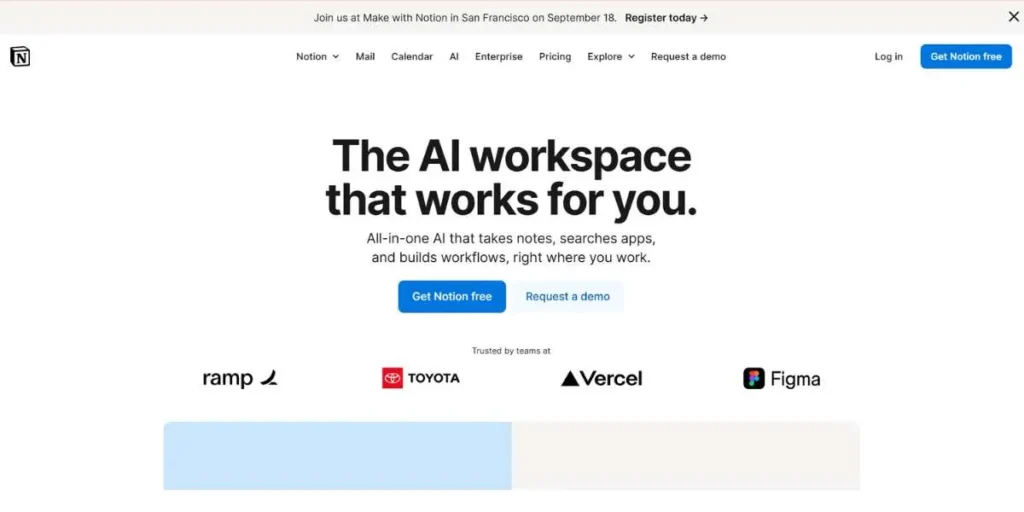
Notion AI has been built into a popular productivity platform to provide efficient performance in the workspace with the help of intelligent writing assistant, data analysis, and content organization features. As a powerful example of AI Virtual Assistant Software, the fluidity of this integration makes Notion an all-encompassing AI-driven productivity workspace for organizations and individuals across the globe. The 2025 version includes better database querying, better template generation, and improved workflow automation.
Features:
- Integration with Native Notion workspace environment
- Smart writing support and text enhancement
- Functionality of database query and analysis
- Generation of templates and automation of workflow
- Team productivity tools based on AI Collaboration
Pricing:
- Notion AI add-on: 10 dollars/user/month
- Notion Plus: 10$/user/month (base workspace)
- Notion Business: 18/user/month
- Notion Enterprise: Custom pricing
Pros:
- Smooth integration with current Notion processes
- Context-sensitive help in documents
- Teamwork functions in teams Collaborative functions in teams
- Low prices on current Notion owners
Cons:
- Needs subscription to Notion
- Not much functionality beyond the Notion environment
- New user learning curve of Notion
- AI reliance on the Internet
Website: https://www.notion.com/product/ai
8. ClickUp Brain
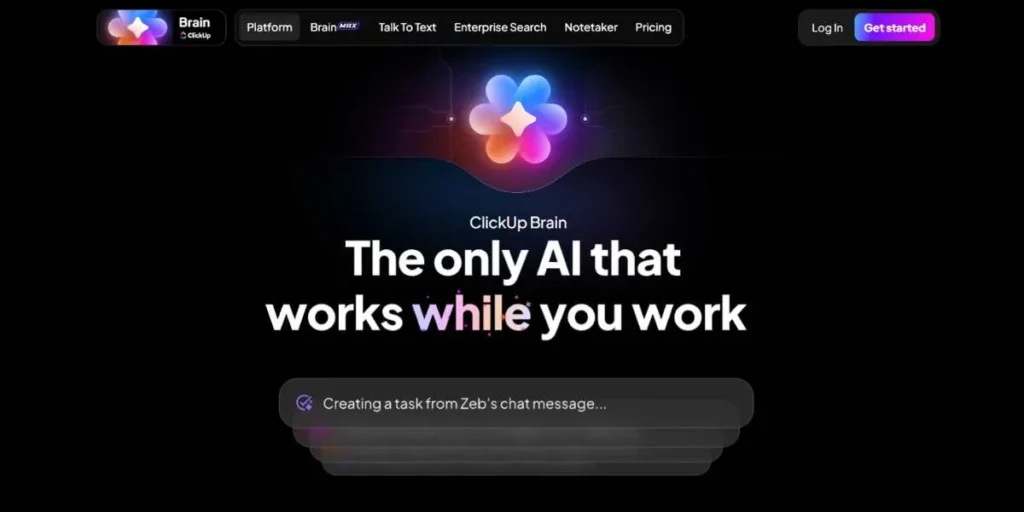
ClickUp Brain is a customizable AI functionality embedded into the complex ClickUp productivity system, revolutionizing project management by automating tasks and optimizing the company workflow via the intelligence of the algorithm. The 2025 model has better content creation, powerful data analysis and reporting automation tools. This AI assistant is proficient in project coordination, document creation, and improvement suggestion of the process and remains very much integrated with the comprehensive ClickUp feature set.
Features:
- Task optimization and automation of project management
- Smart document creation and content generation
- Automation of reporting and analysis of data
- Workflow recommendations and process improvement
- Cross-platform integration to productivity tools
Pricing:
- ClickUp Brain: 7 dollars per workspace member per month
- Unlimited Plan: 10 dollars a month per user (base ClickUp)
- Business Plan: 19/user/month
- Enterprise: Prices are custom
Pros:
- Closely integrated with the workflows of project management
- Full-featured productivity line-up
- Pricing of team environments is low-cost
- Constantly enhanced features and updates
Cons:
- Need ClickUp subscription to use the whole functionality
- The new user can be intimidated by complex interface
- Few AI capabilities beyond ClickUp ecosystem
- Advert advanced features learning curve
Website: https://clickup.com/brain
9. Perplexity AI
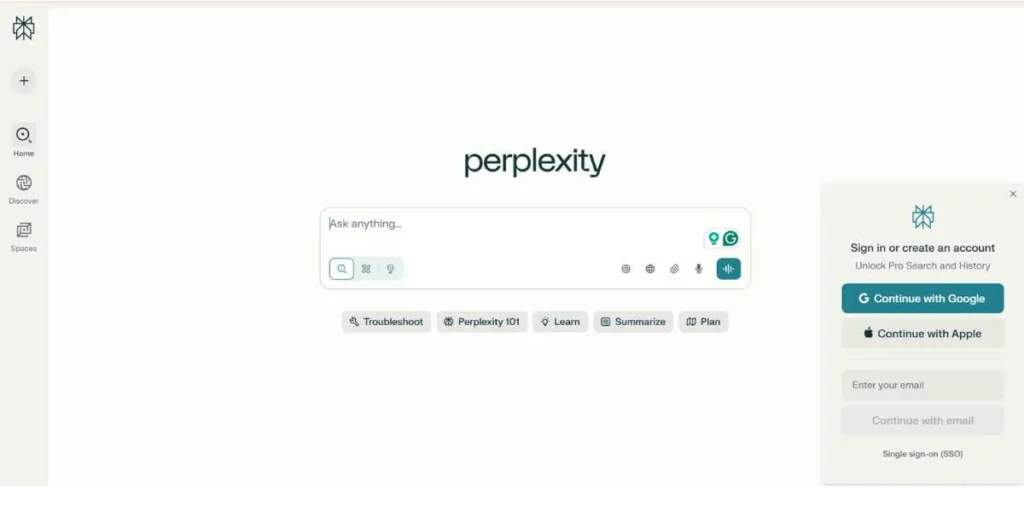
Perplexity AI transforms information retrieval by using AI-driven search engine features to deliver fast and detailed, source-verified responses to intricate questions with immediate access. It differs from traditional search engines in its allowing advanced natural language processing to provide conversational experiences of search that include detailed source citations and the ability to fact-check. The 2025 version is more academically research-friendly, more multi-modally (including images and documents) searchable, and offers a better source verification system.
Features:
- Source citation with real time information retrieval
- Follow-up questions and interface in conversational search
- Query processing Academic and research oriented
- Both image and document multi-modal search
- Checking sources and Fact-checking tools
Pricing:
- Perplexity Free: 0/month, limited queries a day
- Perplexity Pro: 20 dollars a month unlimited queries
- Team plans: Beginning at 40$/month
- Enterprise solutions: Custom pricing
Pros:
- Superb source validation and reference
- On the fly access and updates of information
- Functionality academic and research oriented
- Distraction-free design of interface Clean design
Cons:
- Few creative and content producing capabilities
- Restrictions on free tier
- Younger platform that is developing feature set
- Internet reliance on everything
Website: https://www.perplexity.ai/
10. Lindy AI
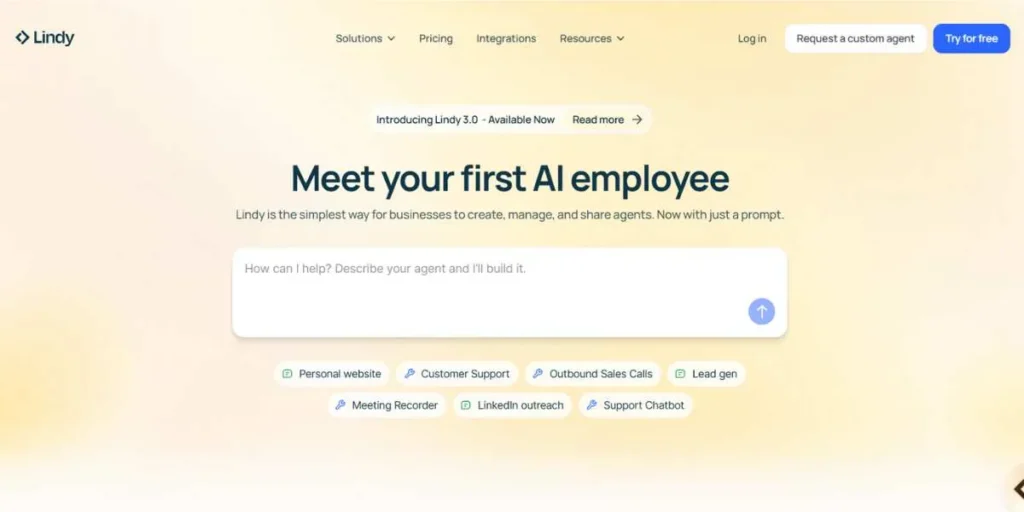
Lindy can be described as a full-service AI employee platform that provides customizable digital assistants that can be used in many different industries and functions of businesses to manage complex business processes, customer relations, and automation of workflow. The 2025 release includes better AI agent development tools, better optimization of business processes and wider integration with common business systems. Lindy is highly-rated at customer service automation, high-level workflow management, and scalable solution implementation to the developing organization.
Features:
- Deployable and customizable AI agent creation
- Business processes automation and optimization
- Customer services and automation of support
- Connection to other popular business programs
- Superior task and workflow control
Pricing:
- Starter Plan: 29/month basic automation
- Advanced Plan: 99 dollars a month with professional features
- Enterprise Plan: US299/mo full functionality
- Custom Solutions: Special pricing to large bodies
Pros:
- Extremely flexible AI agent functions
- High business process automation orientation
- Holistic integration eco system
- Scalable to expand to the organizations.
Cons:
- Steep prices in comparison to consumer products
- Needs technical installation and configuration
- A small number of consumer-oriented functions
- Optimal implementation learning curve
Website: https://www.lindy.ai/
11. Socratic by Google
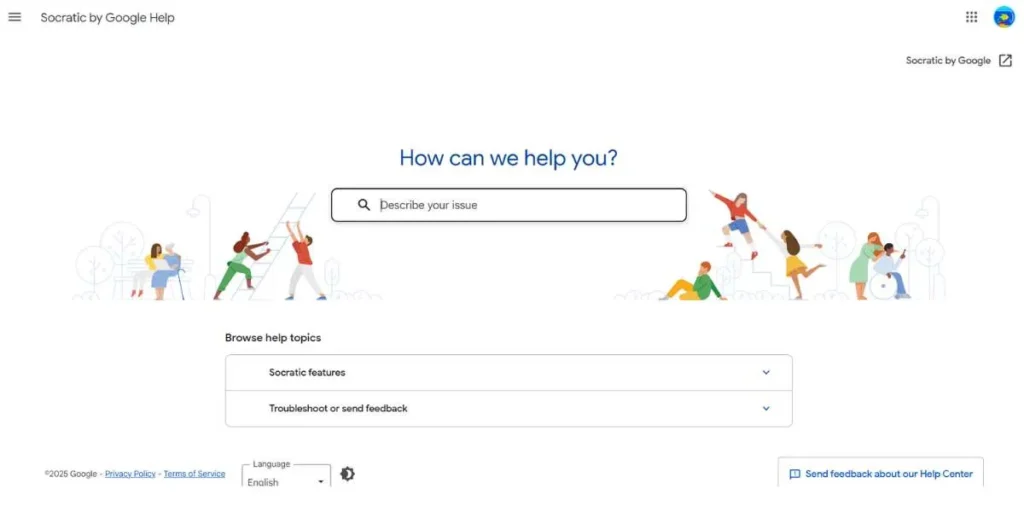
Targeted at students and school settings, Socratic is a product that makes use of Google advanced AI technology to offer comprehensive home work assistance, concept clarifications, and learning aid in a variety of academic disciplines with fresh visual recognition mechanisms. Version 2025 includes better camera-based problem identification, more-detailed step-by-step solutions, and more recommendations of educational resources. Socratic is an excellent tool in mathematics, sciences, literature and social studies having an interface design that is friendly to students and explanations are clear.
Features:
- The camera in solving and recognition of problems
- Explanations and subject specific learning support
- Instructional steps Piece by piece
- Suggestions of learning materials
- Access to Google knowledge base
Pricing:
- Socratic: No fees to download and use
- Google Workspace for Education: Schools get it free
- Elite education extras: Packaged in
- No subscription charges to pay
Pros:
- Entirely gratis instructional tool
- Superb problem recognition in sight
- Full coverage of subjects
- Easy to use interface and explanation to students
Cons:
- It is restricted to educational and academic purposes
- No commercial or professional software
- Functionality is enhanced by the use of mobile device
- The low level of customization
Website: https://lens.google/#homework
12. Replika

Replika has a differentiating approach to AI companionship with an emphasis on emotional support, personal growth, and meaningful conversational interaction with personal AI companions who learn about the user and support emotional wellness. The 2025 model introduces superior emotional intelligence, the personality development options of the higher quality, and the mood tracking features of greater scope. Replika is a great app at creating safe emotional release zones, daily check-ins, and mental health support talks, without any judgment.
Features:
- Emotional intelligence AI companion on a personal level
- Mental health and wellness promote the discussion
- Development and customization of personality
- Check-ins and mood tracking everyday
- Emotional expression safety
Pricing:
- Replika Free: Free basic conversation
- Replika Pro: 19.99/month premium features
- One year subscription: 69.99/yr (discounted)
- Lifetime access: $299.99 single purchase
Pros:
- Special concern with emotional support and companionship
- Personalized & Adaptive
- Mental health and well being
- Non-judgmental safe atmosphere of conversation
Cons:
- Very few real use products on practical productivity
- Premium features require the subscription
- Possible dependency issues
- Unfit to do business or professional work
Website: https://replika.ai/
13. Otter.ai
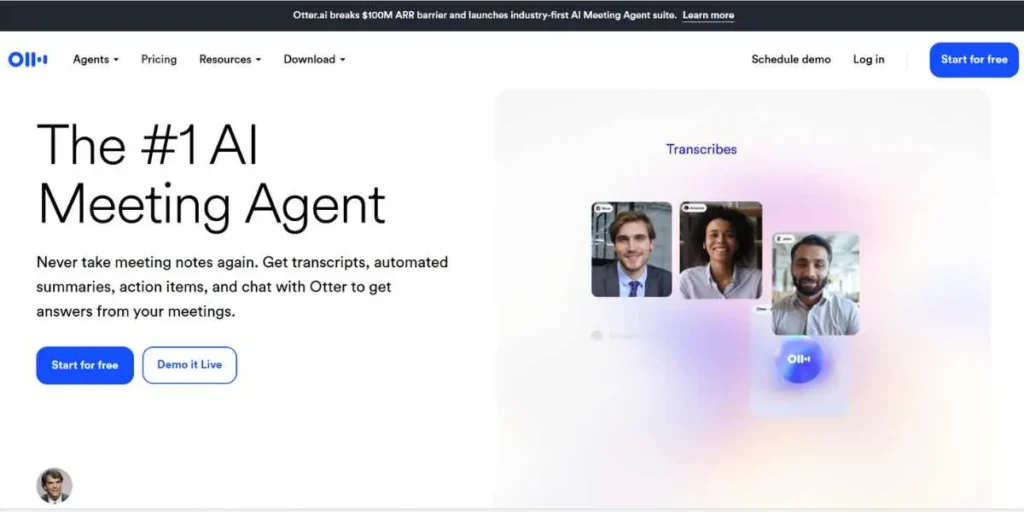
A specialist in transcription and comprehensive note taking, Otter.ai transcribes audio discussions into a searchable and shareable text format, with advanced speaker identification, keyword-highlighting capabilities, and integration with the most-used video conferencing tools. The 2025 version includes better transcription accuracy, a higher ability to generate summaries, and more features on collaboration in a team setting. Otter.ai is the best at real-time meeting minutes, automatic key points extraction, and searchable archive transcripts, and organization tools.
Features:
- Speaker identification transcription of a meeting in real time
- Automatic generation of summaries and extracting main points
- Combination with Zoom, Teams and Google Meet
- Common note-taking and sharing functions
- Transcript archive / organization (searchable)
Pricing:
- Otter Basic: 600 minutes/month of free use
- Otter Pro: 16.99/month per person
- Otter Business: 30 /user/month (teams)
- Otter Enterprise: Custom pricing to organizations
Pros:
- Superior quality and velocity of transcription
- Completely compatible with video conferencing systems.
- Teamwork capabilities Team environment Collaborative capabilities
- Automatic key point extraction and automatic summary
Cons:
- Small functionality beyond transcription of meetings
- Long term use requires subscription
- The quality of audio may be different in terms of accuracy
- Sensitive meetings privacy considerations
Website: https://otter.ai/
14. Motion
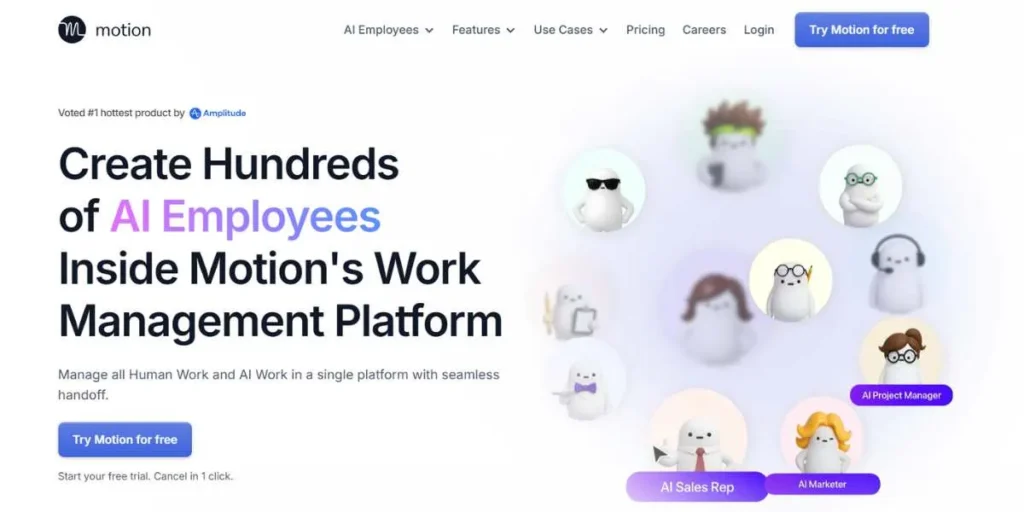
Motion integrates the power of AI in scheduling with extensive task management to build smart calendars that can automatically balance time allocation, prioritize tasks and adjust to evolving schedules to optimize productivity. The 2025 model will have better coordination of the calendar, better task prioritization algorithms and enhanced productivity analytics with insights. Motion is great in smart time blocking, automatic meeting scheduling and project management (with deadline tracking option).
Features:
- Smart calendar optimizing and schedule
- Task prioritization and time blocking is generated automatically
- Project management with an interface on tracking the deadlines
- Automation of scheduling and coordination of meetings
- Analytics and insights on productivity
Pricing:
- Personal Plan: 34/month personally
- Team Plan: 20 dollars per user per month small teams
- Custom Enterprise: Organizational tailored pricing
- Yearly discounts: Up to 33 per cent off
Pros:
- Smarter scheduling and time management
- All-inclusive task and project management
- Automatic coordination and planning of a calendar
- Good productivity analytics and insights
Cons:
- Pricing above the basic calendar apps
- Optimal setup and usage Learning curve
- Few free tier or trial options
- Will produce best results with consistent input
Website: https://www.usemotion.com/
How to Choose the Right AI Virtual Assistant Software
- Functionality Check: Find main features that fit your main use cases, be it productivity, creativity, customer service or personal assistance
- Integration Capabilities: Learn about the compatibility of the platform to your existing software environment, including email clients, calendar applications and business systems
- Pricing Structure Analysis: Analyze subscription prices, usage caps, and scalability to make sure that it will be affordable and worthy of investment in the long term
- Security and Privacy Factors: Evaluate data security, encryption levels, compliance certifications and user control of personal data
- Quality of user experience: Check interface design, learning curve, personalization possibilities and ease of use in general in order to maximize adoption
- Support and Reliability Factors: Look at the availability of customer service, stability of the platform, how often it’s updated, and any community resources to help troubleshoot.
Future Trends in AI Virtual Assistants
- Magnified Emotional Intelligence: Allow systems to learn and interact with human emotions with greater understanding, so as to make interactions more personal and empathetic
- Multimodal Interaction Progress: Add voice, text, visual and gesture inputs to make communication more natural and intuitive
- Specialization on Industry: Create industry-specific solutions in areas of healthcare, finance, education, and more that have specialized knowledge bases and compliance characteristics
- Greater Privacy and Security: Employ superior encryption, on-device, and data management where the user decides what to do with data and location of data storage.
- Advanced Reasoning and Problem-Solving: Enable systems to do advanced analytical work and provide advanced decision-support services
- Cross-Platform Integration: ensure consistent cross-device, cross-application, and cross-service experiences, including in terms of AI assistance, which is now genuinely omnipresent and context-aware
Common Challenges and How to Overcome Them
- Privacy and Security Issues: It should be evaluated closely with the vendors, data encryption checked and understanding of privacy policy needed before committing to the platform
- Integration Complexity: This should be handled by phased implementation, with core functions first and capabilities added as comfort and expertise build
- Cost Management: engage in good ROI analysis using free or low-cost options and investing more as value and growth are proven
- Resistance to User Adoption: Engages benefits of full training programs, effective communication of benefits and the slow release of features to gain confidence
- Accuracy and Reliability Problems: Demands realistically setting expectations, ongoing monitoring, giving feedbacks, and setting up backup processes of critical work
- Dependency Issues: Counteract by means of skill preservation, alternative solution knowledge, and tactical human management so the operation can be independent
Conclusion
The intelligent digital assistance landscape has become more refined than ever before, and it is capable of providing revolutionary solutions to productivity, creativity, and operational efficiency in both personal and professional domains. Such sophisticated platforms are not merely the technological tools, but are intelligent companions that can read context, learn preference and respond to the changing needs. Whether it is the ecosystem dominance of Amazon or the conversational achievements of OpenAI, every solution has its own advantages that can be used in different use cases and needs.
The secret to success is careful selection depending on personal needs, integration needs and long-term goals. With the continued development of artificial intelligence, such digital companions will become a key piece to stay ahead of competition and remain productive on a personal level as well. The future holds even more possibilities, individualization and a perfect fusion of all digital life as AI Virtual Assistant Software is not only an advantageous investment but the key to surviving in the digital world of tomorrow.
FAQs
Q1: Are the AI virtual assistants safe to use in business?
Enterprise level platforms also adopt strong security such as end-to-end encryption, compliance certifications, and data governance policies. Nevertheless, privacy policies and security features should be reviewed at all times before they are implemented.
Q2: Do AI virtual assistants work on an offline basis?
Most of the platforms have significant offline limitations but the furthest features depend on the internet connection where the process is operated on the cloud and the information is accessed in real-time. Apple Siri and Google Assistant are a few systems that have offline capabilities.
Q3: What are the prices of AI virtual assistant solutions?
Although the cost of virtual assistants in smart devices, such as Amazon Alexa, is usually part of the cost of a device or subscription, task-specific assistants, e.g., collaboration or project management, may cost between $10 and more than 200 dollars a month.
Q4: What is the distinction between chatbots and AI virtual assistants?
The AI virtual assistants can be more advanced in terms of natural language processing, context-retention, multi-modal interactions, and complex task-execution, whereas chatbots in most cases are concerned with simple, predefined answers and simple customer service tasks.
Q5: Is it possible to combine several AI virtual assistants at the same time?
Yes, some users are effectively integrating multiple platforms to their perceived advantages, e.g. Alexa to control smart home, ChatGPT to create content, and Google Assistant to make search requests.